Integration of Historical and Contemporary Data Sources in Understanding the Extent and Types of Disruptions in the Syrdarya Delta Land Use/Land Cover
Abstract
1. Introduction
2. Methods and Materials
2.1. Qualitative Historical Data
2.2. Analysis of Historical Maps
2.3. Remote Sensing
- -
- 16 May 1977;
- -
- 14 May 1986;
- -
- 15 May 2001;
- -
- 16 May 2010;
- -
- 27 May 2020;
- -
- 27 May 2022.
- Georeferencing of Landsat satellite images for the study area.
- Preliminary unsupervised image classification in order to identify landscape clusters, including built areas, agricultural land, wet zones and dry zones.
- Application of specific features to delineate entities from the identified clusters:
- Normalized Difference Vegetation Index (NDVI) for identification of vegetated areas and their changes in the SD.
- Normalized Difference Water Index (NDWI) for delineation of water bodies in the SD.
- Normalized Difference Built-up Index (NDBI) for identification and analysis of built areas in the SD.
- Normalized Difference Moisture Index (NDMI) for differentiation between crops and other vegetation identified through NDVI.
- Manual interpretation in specific regions, particularly in agricultural areas.
- Calculation of areal metrics and comparative data analysis.
- Production of spatial outputs.
3. Results
4. Discussion
“Mr. L. Berg’s book appears as a first attempt to give us detailed description of one of the largest interior water areas in Russia from physical and geographical point of view, not so much in the form of a compilation, but principally as a study based on his own observations and exploration. The book is therefore to be welcomed; and it is bound to occupy a foremost place among Russian limnological works” [60] (Markov, 1911, p. 515).
“I am not aware that the limited number of irrigation canals which exists on the lower courses of the Syr have their heads dammed and their beds cleared of deposit… the difference of treatment probably results from the irrigation on the lower Syr being on a much less extensive scale and unmethodical; and is also perhaps due to the different ethnic character of the respective populations, who have inherited different traditions from their ancestors” [25] (Wood, 1876, p. 397).
Environmental History of the Syrdarya Delta During the USSR and Since Then
5. Summary and Conclusions
Author Contributions
Funding
Data Availability Statement
Acknowledgments
Conflicts of Interest
References
- Cameron, S. The Hungry Steppe: Famine, Violence, and the Making of Soviet Kazakhstan; Cornell University Press: Ithaca, NY, USA, 2018. [Google Scholar]
- Jelen, I.; Angelija, B.; Francesco, C. Geography of Central Asia; Springer International Publishing: Berlin/Heidelberg, Germany, 2020. [Google Scholar]
- Kindler, R. Stalin’s Nomads: Power and Famine in Kazakhstan; University of Pittsburgh Press: Pittsburgh, PA, USA, 2018. [Google Scholar]
- Micklin, P.P. The future Aral Sea: Hope and despair. Environ. Earth Sci. 2016, 75, 844. [Google Scholar] [CrossRef]
- Ermakhanov, Z.K.; Plotnikov, I.S.; Aladin, N.V.; Micklin, P. Changes in the Aral Sea ichthyofauna and fishery during the period of ecological crisis. Lakes Reserv. Res. Manag. 2012, 17, 3–9. [Google Scholar] [CrossRef]
- Golden, P. Central Asia in World History; Oxford University Press: Oxford, UK, 2011. [Google Scholar]
- Keating, J. “There are few plants, but they are growing, and quickly”: Foliage and the aesthetics of landscape in Russian Central Asia, 1854–1914. Stud. Hist. Gard. Des. Landsc. 2017, 37, 174–189. [Google Scholar] [CrossRef]
- Taltakov, I. The Syr Darya River- New ecological disaster in Central Asia. Acta Sci. Pol. Form. Circumiectus 2015, 14, 135–140. [Google Scholar] [CrossRef]
- Williams, M. Climate Change in Deserts: Past, Present and Future; Cambridge University Press: Cambridge, UK, 2014. [Google Scholar]
- Wood, F. The Silk Road; University of California Press: Berkeley, CA, USA, 2012. [Google Scholar]
- Khai, R.Y. Creation of system “Delta-Sea” as a basis of ecosystem approach to the management of large Aral Sea’s coastal zone. In Management and Sustainable Development of Coastal Zone Environments; Ramanathan, A.L., Bhattacharya, P., Dittmar, T., Prasad, M.B.K., Neupane, B.R., Eds.; Springer: Dordrecht, The Netherlands, 2010. [Google Scholar]
- Kuz’mina, Z.V.; Shinkarenko, S.S.; Solodovnikov, D.A. Main tendencies in the dynamics of floodplain ecosystems and landscapes of the lower reaches of the Syr Darya river under modern changing conditions. Arid. Ecosyst. 2019, 9, 226–236. [Google Scholar] [CrossRef]
- Zhang, W.; Ma, L.; Abuduwaili, J.; Ge, Y.; Issanova, G.; Saparov, G. Hydrochemical characteristics and irrigation suitability of surface water in the Syr Darya River, Kazakhstan. Environ. Monit. Assess. 2019, 191, 572. [Google Scholar] [CrossRef]
- Andrianov, B.V. The history of economic development in the Aral Region and its influence on the environment. GeoJournal 1995, 35, 11–16. [Google Scholar] [CrossRef]
- Féaux de la Croix, J.; Arzhantseva, I.; Dağyeli, J.; Dubuisson, E.M.; Härke, H.; Penati, B.; Wooden, A. Roundtable studying the Anthropocene in Central Asia: The challenge of sources and scales in human–environment relations. Cent. Asian Surv. 2022, 41, 180–203. [Google Scholar] [CrossRef]
- Micklin, P.P. Efforts to revive the Aral Sea. In The Aral Sea; Springer: Berlin/Heidelberg, Germany, 2014. [Google Scholar]
- Mitrofanov, I.V.; Mamilov, N.S. Fish diversity and fisheries in the Caspian Sea and Aral-Syr Darya basin in the Republic of Kazakhstan at the beginning of the 21st Century. Aquat. Ecosyst. Health Manag. 2015, 18, 160–170. [Google Scholar] [CrossRef]
- Penati, B. Explorations in the Social History of Modern Central Asia (19th-Early 20th Century); Brill: Leiden, The Netherlands, 2013. [Google Scholar]
- Zhou, Y.; Zhang, L.; Fensholt, R.; Wang, K.; Vitkovskaya, I.; Tian, F. Climate contributions to vegetation variations in Central Asian drylands: Pre-and post-USSR collapse. Remote Sens. 2015, 7, 2449–2470. [Google Scholar] [CrossRef]
- Berg, L.S. The Aral Sea: An experience of physics-geographic monography. Izv Turkestanskogo Otd Rus. Geogr Obs. 1908, 5, 580. [Google Scholar]
- Boutakoff, A. Survey of the Sea of Aral. J. R. Geogr. Soc. 1853, XXIII, 93–101. [Google Scholar] [CrossRef]
- Lansdell, H. Russian Central Asia: Including Kuldja, Bokhara, Khiva and Merv; Sampson Low, Marston, Searle and Rivington: London, UK, 1885; Volume 2. [Google Scholar]
- Popova, I.F. (Ed.) Russian Explorations in Central Asia at the Turn of the 20th Century; Slavia: Prague, Czech, 2008. [Google Scholar]
- Walker, D. The Pundits: British Exploration of Tibet and Central Asia; Kentucky University Press: Lexington, KY, USA, 2004. [Google Scholar]
- Wood, H. Notes on the Lower Amú-darya, Syr-darya and Lake Aral, in 1874. J. R. Geogr. Soc. Lond. 1876, 45, 367–413. [Google Scholar] [CrossRef]
- Zonn, I.S.; Kosarev, A.N. History of investigation and exploration of the Aral Sea. In The Aral Sea Environment, The Handbook of Environmental Chemistry; Kostianoy, A., Kosarev, A., Eds.; Springer: Berlin/Heidelberg, Germany, 2010; Volume 7, pp. 11–23. [Google Scholar]
- Peterson, M. Pipe Dreams—Water and Empire in Central Asia’s Aral Sea Basin; Cambridge University Press: Cambridge, UK, 2019. [Google Scholar]
- Becker, S. Russia’s Protectorates in Central Asia: Bukhara and Khiva, 1865–1924; Routledge: Oxfordshire, UK, 2004; Volume 5. [Google Scholar]
- Edney, M.H. Mapping an Empire: The Geographical Construction of British India, 1765–1843; University of Chicago Press: Chicago, IL, USA, 2009. [Google Scholar]
- Keating, J. On Arid Ground: Political Ecologies of Empire in Russian Central Asia; Oxford University Press: Oxford, UK, 2022. [Google Scholar]
- Morrison, A. The Russian Conquest of Central Asia: A Study in Imperial Expansion, 1814–1914; Cambridge University Press: Cambridge, UK, 2021. [Google Scholar]
- Fuchs, R.; Verburg, P.H.; Clevers, J.G.P.W.; Herold, M. The potential of old maps and encyclopedias for reconstructing historic European land cover/use change. Appl. Geogr. 2015, 59, 43–55. [Google Scholar] [CrossRef]
- Gaddis, J.L. The Landscape of History: How Historians Map the Past; Oxford University Press: Oxford, UK, 2002. [Google Scholar]
- Gregory, I.N. A Place in History: A Guide to Using GIS in Historical Research; Oxbow: West Palm Beach, FL, USA, 2002. [Google Scholar]
- Hamre, L.N.; Domaas, S.T.; Austad, I.; Rydgren, K. Land-cover and structural changes in a Western Norwegian cultural landscape since 1865, based on an old cadastral map and field survey. Landsc. Ecol. 2007, 22, 1563–1574. [Google Scholar] [CrossRef]
- Levin, E.E.; Gasith, A. Decline of wetland ecosystems in the coastal plain of Israel during the 20th century: Implications for wetland conservation and management. Landsc. Urban Plan. 2009, 92, 220–232. [Google Scholar] [CrossRef]
- Börjeson, L. Using a historical map as a baseline in a land-cover change study of Northeast Tanzania. Afr. J. Ecol. 2009, 47 (Suppl. S1), 185–191. [Google Scholar] [CrossRef]
- Cruickshank, J.L. Military mapping by Russia and the Soviet Union. In The History of Cartography, v. 16: Cartography in the Twentieth Century; Monmonier, M., Ed.; University of Chicago Press: Chicago, IL, USA, 2015; pp. 932–942. [Google Scholar]
- Gregory, I.N.; Eli, P.S. Historical GIS; Cambridge University Press: Cambridge, UK, 2007. [Google Scholar]
- Goodchild, M.F. Prospects for a space–time GIS: Space-time integration in geography and GIScience. Ann. Assoc. Am. Geogr. 2013, 103, 1072–1077. [Google Scholar] [CrossRef]
- Gregory, I.N.; Dorling, D.; Southall, H.R. A century of inequality in England and Wales using standardized geographical units. Area 2001, 33, 297–311. [Google Scholar] [CrossRef]
- Gheyle, W.; Trommelmans, R.; Bourgeios, J.; Goossens, R.; Bourgeios, I.; Wulf, A.D.; Willems, T. Evaluating CORONA: A case study in the Altai Republic (South Siberia). Antiquity 2004, 78, 391–403. [Google Scholar] [CrossRef]
- Maman, S. Mobility and Stability of the Central Asian Sand Seas (Karakum and Kyzylkum): A Study by Remote Sensing and GIS; Ben-Gurion University of the Negev: Beersheba, Israel, 2012. [Google Scholar]
- Narama, C. The Lake-Level Changes in Central Asia During the Last 1000 years Based on Historical Map. Proceedings of International Workshop on “Reconceptualizing Cultural and Environmental Change in Central Asia: An Historical Perspective on the Future”, 2010, pp. 11–27. Available online: https://www.chikyu.ac.jp/ilipro/page/18-publication/workshop-book/workshop-book_individual%20files/1-2_Narama.pdf (accessed on 5 March 2025).
- Zhang, L.; Weng, Q.; Shao, Z.F. An evaluation of monthly impervious surface dynamics by fusing Landsat and MODIS time series in the Pearl River Delta, China, from 2000 to 2015. Remote Sens. Environ. 2017, 201, 99–114. [Google Scholar] [CrossRef]
- He, F.; Li, M.; Li, S.; Xiao, R. Comparison of changes in land use and land cover in China and the USA over the past 300 years. J. Geogr. Sci. 2015, 25, 1045–1057. [Google Scholar] [CrossRef]
- Liu, Y.; Yue, T.; Jiao, Y.; Zhao, N.; Zhao, M. Temperature changes in the Heihe River Basin based on high accuracy surface modelling. Meteorol. Appl. 2019, 26, 720–732. [Google Scholar] [CrossRef]
- Ben-Dor, E.; Chabrillat, S.; Demattê, J.A.M.; Taylor, G.R.; Hill, J.; Whiting, M.L. Using imaging spectroscopy to study soil properties. Remote Sens. Environ. 2009, 113 (Suppl. S1), S38–S55. [Google Scholar] [CrossRef]
- Maman, S.; Orlovsky, L.; Blumberg, D.G.; Berliner, P.; Mamedov, B. A landcover change study of takyr surfaces in Turkmenistan. J. Arid. Environ. 2011, 75, 842–850. [Google Scholar] [CrossRef]
- Jiang, H. Stories remote sensing images can tell: Integrating remote sensing analysis with ethnographic research in the study of cultural landscapes. Hum. Ecol. 2003, 31, 215–232. [Google Scholar] [CrossRef]
- Zhang, C.; Lu, D.; Chen, X.; Zhang, Y.; Maisupova, B.; Tao, Y. The spatiotemporal patterns of vegetation coverage and biomass of the temperate. deserts.in Central Asia and their relationships with climate controls. Remote Sens. Environ. 2016, 175, 271–281. [Google Scholar] [CrossRef]
- Yang, Y.; Zhang, S.; Yang, J.; Xing, X.; Wang, D. Using a cellular Automata-Markov model to reconstruct spatial land-use patterns in Zhenlai county, Northeast China. Energies 2015, 8, 3882–3902. [Google Scholar] [CrossRef]
- Andreyev, A.I.; Baskhanov, M.; Yusupova, T. The Quest for Forbidden Lands: Nikolai Przhevalskii and His Followers on Inner Asian Tracks; Brill: Leiden, The Netherlands, 2018. [Google Scholar]
- Isenberg, A. The Oxford Handbook of Environmental History; Oxford University Press: Oxford, UK, 2014. [Google Scholar]
- Josephson, P.; Dronin, N.; Mnatsakanian, R.; Cherp, A.; Efremenko, D.; Larin, V. An Environmental History of Russia; Cambridge University Press: Cambridge, UK, 2013. [Google Scholar]
- Zokirov, B.I.U. Works of foreign tourists visiting Central Asia in the XIX century as a source in the study of regional ethnotoponyms. Curr. Res. Joarnal Hist. 2021, 2, 33–38. [Google Scholar] [CrossRef]
- Shaw, D.J.; Oldfield, J.D. Soviet geographers and the great patriotic war, 1941–1945: Lev Berg and Andrei Grigor’ev. J. Hist. Geogr. 2015, 47, 40–49. [Google Scholar] [CrossRef]
- Erkinov, A. The conquest of Khiva from a poet’s point of view. In Looking at the Colonizer: Cross-Cultural Perceptions in Central Asia and the Caucasus, Bengal, and Related Areas; Eschment, B., Harder, H., Eds.; Ergon Verlag: Würzburg, Germany, 2004; pp. 91–115. [Google Scholar]
- Saiko, T. Environmental Crisis; Routledge: Oxfordshire, UK, 2014. [Google Scholar]
- Markov, E.; Berg, L. The Sea of Aral. Geogr. J. 1911, 38, 515–519. [Google Scholar] [CrossRef]
- Beysenova, A.S. Rol’ russkikh uchenykh v poznanii prirody Kazakhstana (s drevneyshikh vremen do serediny XX veka). In The Role of Russian Scientists in the Knowledge of the Nature of Kazakhstan (from Ancient Times Until the Middle of the 20th Century); Mektep: Almaty, Kazakhstan, 2011. (In Russain) [Google Scholar]
- Keller, S. Russia and Central Asia—Coexistence, Conquest, Convergence; University of Toronto Press: Toronto, ON, Canada, 2020. [Google Scholar]
- Pianciola, N. Cossacks and Sturgeons: Fisheries, Colonization, and Science around the Aral Sea (1873–1906). J. Econ. Soc. Hist. Orient 2019, 62, 626–673. [Google Scholar] [CrossRef]
- Boutakoff, A.; Michell, J. The Delta and Mouths of the Amu-Daria, or Oxus. J. R. Geogr. Soc. Lond. 1867, 37, 152–160. [Google Scholar] [CrossRef]
- Boutakoff, A. Svedinya ob expedizie, snaryjonoy dlya opisi Aral’skoe more v 1848 g. Vestnik Russk. Geogr. Obshchestva 1853, VII, 1–7. (In Russian) [Google Scholar]
- Penati, B. The Cotton Boom and the Land Tax in Russian Turkestan (1880s–1915). Krit. Explor. Russ. Eurasian Hist. 2013, 14, 741–774. [Google Scholar] [CrossRef]
- Zhang, M.; Luo, G.; De Maeyer, P.; Cai, P.; Kurban, A. Improved atmospheric modelling of the oasis-desert system in Central Asia using WRF with actual satellite products. Remote Sens. 2017, 9, 1273–1300. [Google Scholar] [CrossRef]
- Wuepper, D.; Borrelli, P.; Mueller, D.; Finger, R. Quantifying the soil erosion legacy of the Soviet Union. Agricultural Systems 2020, 185, 102940. [Google Scholar] [CrossRef]
- Berg, L.S. Aral’skoe More; MM Stasyulevicha: Saint Petersburg, Russian, 1908. [Google Scholar]
- Abuduwaili, J.; Issanova, G.; Saparov, G. Hydrology and Limnology of Central Asia; Springer: Berlin/Heidelberg, Germany, 2018. [Google Scholar]
- Fierman, W. Soviet Central Asia; Routledge: Oxfordshire, UK, 2019. [Google Scholar]
- Keating, J. Amid the horrors of nature: ‘dead’ environments at the margins of the Russian empire. In Empty Spaces: Perspectives on Emptiness in Modern History; Keating, J., Campbell, C.J., Giovine, A., Eds.; University of London Press: London, UK, 2019; pp. 33–58. [Google Scholar]
- Peterson, M.U.S. to USSR: American experts, irrigation, and cotton in Soviet Central Asia, 1929–1932. Environ. Hist. 2016, 21, 442–466. [Google Scholar] [CrossRef]
- Breyfogle, N.B. Toward an environmental history of tsarist Russia and the Soviet Union. In Eurasian Environments: Nature and Ecology in Imperial Russian and Soviet History; University of Pittsburgh Press: Pittsburgh, PA, USA, 2018; pp. 3–20. [Google Scholar]
- Kent, A.J.; Davies, J.M. Hot geospatial intelligence from a Cold War: The Soviet military mapping of towns and cities. Cartogr. Geogr. Inf. Sci. 2013, 40, 248–253. [Google Scholar] [CrossRef]
- Li, Z.; Chen, Y.; Li, W.; Deng, H.; Fang, G. Potential impacts of climate change on vegetation dynamics of Central Asia. J. Geophys. Res.—Atmos. 2015, 120, 2045–2057. [Google Scholar] [CrossRef]
- Aralova, D.; Kariyeva, J.; Khujanazarov, T.; Toderich, K. Drought variability and land degradation in Central Asia: Assessment using remote sensing data and drought indices. In Vegetation of Central Asia and Environs; Egamberdieva, D., Öztürk, M., Eds.; Springer: Berlin/Heidelberg, Germany, 2018; pp. 15–47. [Google Scholar]
- Babaev, A.G. (Ed.) Desert Problems and Desertification in Central Asia; Springer: Berlin/Heidelberg, Germany, 2012. [Google Scholar]
- Cameron, S. Review of Imperial Desert Dreams. Cotton Growing and Irrigation in Central Asia, 1860–1991, by J. Obertreis. Jahrbücher Für Gesch. Osteur. 2020, 68, 569–571. Available online: https://www.jstor.org/stable/27073847 (accessed on 5 March 2025).
- Liastchenko, P.I. Technical Reconstruction and the Growth of Production in the Agriculture of the USSR. J. Farm Econ. 1934, 16, 539–543. [Google Scholar] [CrossRef]
- Miller, M. Khrushchev and the Development of Soviet Agriculture: The Virgin Land Programme 1953–1964. Int. Aff. 1977, 53, 498–499. [Google Scholar] [CrossRef]
- Penati, B. Adapting Russian technologies of power: Land-and-Water reform in the Uzbek SSR (1924–1928). Revolut. Russ. 2012, 25, 187–217. [Google Scholar] [CrossRef]
- Brite, E.B. The hydro social empire: The Karakum River and the Soviet conquest of Central Asia in the 20th century. J. Anthropol. Archaeol. 2018, 52, 123–136. [Google Scholar] [CrossRef]
- Arystambekova, D.; Thevs, N.; Tursumbayeva, M. Assessment of the hydroecological state of the Syrdarya Delta. Cent. Asian J. Water Res. 2019, 5, 29–41. [Google Scholar] [CrossRef]
- Josephson, P. War on Nature as Part of the Cold War. The Strategic and Ideological Roots of Environmental Degradation in the Soviet Union. In Environmental Histories of the Cold War; Cambridge University Press: Cambridge, UK, 2010; pp. 21–50. [Google Scholar]
- Lewis, R.A. (Ed.) Geographic Perspectives on Soviet Central Asia; Routledge: Oxfordshire, UK, 1992. [Google Scholar]
- Davies, J. Review of “Russian military mapping: A guide to using the most comprehensive source of global geospatial intelligence”. Cartogr. J. 2006, 43, 259. [Google Scholar]
- Davis, M.; Kent, A.J. Improving user access to Soviet military mapping: Current issues in libraries and collections around the globe. J. Map Geogr. Libr. 2017, 13, 246–260. [Google Scholar] [CrossRef]
- Watt, D. Soviet military mapping. Sheetlines 2005, 74, 9–12. [Google Scholar]
- Cameron, S. Environmental Approaches to Soviet Central Asia. In Oxford Research Encyclopaedia of Asian History; Oxford University Press: Oxford, UK, 2020. [Google Scholar] [CrossRef]
- Davies, J. Uncle Joe knew where you lived: The story of Soviet mapping of Britain (Part I). Sheetlines 2005, 72, 26–38. [Google Scholar]
- Josephson, P.R. “Projects of the Century” in Soviet History: Large-Scale Technologies from Lenin to Gorbachev. Technol. Cult. 1995, 36, 519–559. [Google Scholar]
- Ma, L.; Abuduwaili, J.; Smanov, Z.; Ge, Y.; Samarkhanov, K.; Saparov, G.; Issanova, G. Spatial and vertical variations and heavy metal enrichments in irrigated soils of the Syr Darya River watershed, Aral Sea Basin, Kazakhstan. Int. J. Environ. Res. Public Health 2019, 16, 4398. [Google Scholar] [CrossRef] [PubMed]
- Mazhitova, Z.; Zhalmurzina, A.; Kolganatova, S.; Orazbakov, A.; Satbai, T. Environmental consequences of Khrushchev’s Virgin Land Campaign in Kazakhstan (1950s–1960s). In E3S Web of Conferences; EDP Sciences: Les Ulis, France, 2021; Volume 258, p. 05036. [Google Scholar]
- Yang, Y.; Zhang, S.; Yang, J.; Chang LBu, K.; Xing, X. A review of historical reconstruction methods of land use/land cover. J. Geogr. Sci. 2014, 24, 746–766. [Google Scholar] [CrossRef]
- Zavialov, P. Physical Oceanography of the Dying Aral Sea; Springer: Berlin/Heidelberg, Germany, 2005. [Google Scholar]
- Marx, L. Environmental degradation and the ambiguous social role of science and technology. J. Hist. Biol. 1992, 25, 449–468. [Google Scholar] [CrossRef]
- Breyfogle, N.; Schrader, A.; Sunderland, W. (Eds.) Peopling the Russian Periphery: Borderland Colonization in Eurasian History; Routledge: Oxfordshire, UK, 2007. [Google Scholar]
- Kent, A.J.; Davis, M.; Davies, J. The Soviet mapping of Poland—A brief overview. Misc. Geogr. 2019, 23, 5–15. [Google Scholar] [CrossRef]
- Zonn, I.S. Karakum canal: Artificial River in a desert. In The Turkmen Lake Altyn Asyr and Water Resources in Turkmenistan, The Handbook of Environmental Chemistry; Zonn, I., Kostianoy, A., Eds.; Springer: Berlin/Heidelberg, Germany, 2012; Volume 28, pp. 95–106. [Google Scholar]
- Lioubimtseva, E. Possible changes in the carbon budget of arid and semi-arid Central Asia inferred from land-use/landcover analyses during 1981–2001. In Climate Change and Terrestrial Carbon Sequestration in Central Asia; Lal, R., Suleimenov, M., Stewart, B.A., Hansen, D.O., Doraiswami, P., Eds.; Taylor & Francis: Oxfordshire, UK, 2007; pp. 441–452. [Google Scholar]
- Rumer, B.Z. Investment and Reindustrialization in the Soviet Economy; Routledge: Oxfordshire, UK, 2019. [Google Scholar]
- Lioubimtseva, E.; Cole, R.; Adams, J.M.; Kapustin, G. Impacts of climate and land-cover changes in arid lands of Central Asia. J. Arid. Environ. 2005, 62, 285–308. [Google Scholar] [CrossRef]
- Peterson, M. Engineering empire: Russian and foreign hydraulic experts in Central Asia, 1887–1917. Cah. Monde Russe 2016, 57, 125–146. [Google Scholar] [CrossRef]
- Hofmeister, U. Civilization and Russification in Tsarist Central Asia, 1860–1917. J. World Hist. 2016, 27, 411–442. [Google Scholar] [CrossRef]
- Goudie, A.S. Dust storms: Recent developments. J. Environ. Manag. 2009, 90, 89–94. [Google Scholar] [CrossRef]
- Jiang, L.; Bao, A.; Jiapaer, G.; Guo, H.; Zheng, G.; Gafforov, K.; Kurban, A.; De Maeyer, P. Monitoring land sensitivity to desertification in Central Asia: Convergence or divergence? Sci. Total Environ. 2019, 658, 669–683. [Google Scholar] [CrossRef]
- Kariyeva, J. Land Surface Phenological Responses to Land Use and Climate Variation in a Changing Central Asia. Ph.D. Thesis, University of Arizona, Tucson, AZ, USA, 2010. [Google Scholar]
- Horinkova, V.; Abdullaev, I. Institutional aspects of water management in Central Asia water users’ associations. Water Int. 2003, 28, 237–245. [Google Scholar] [CrossRef]
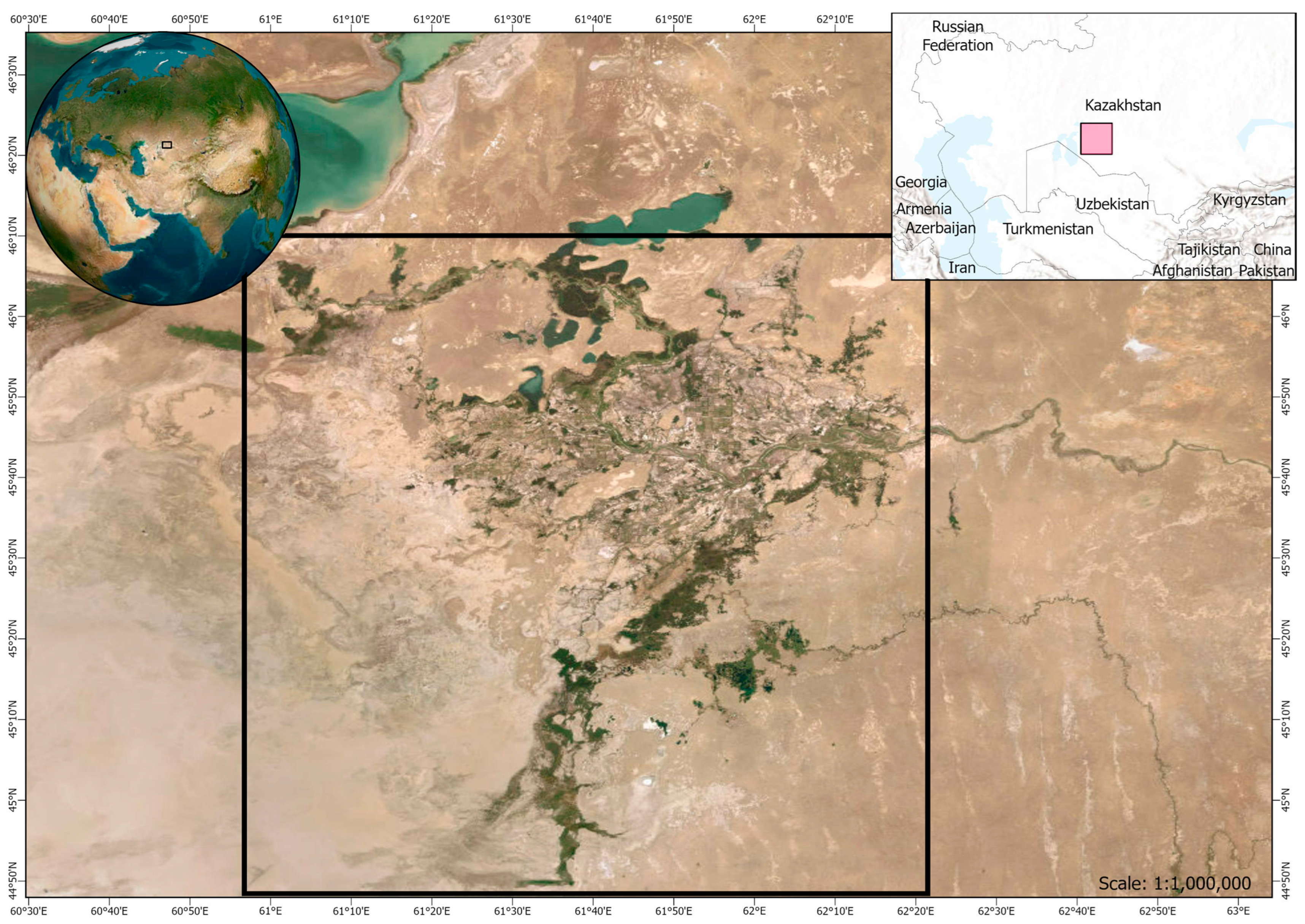
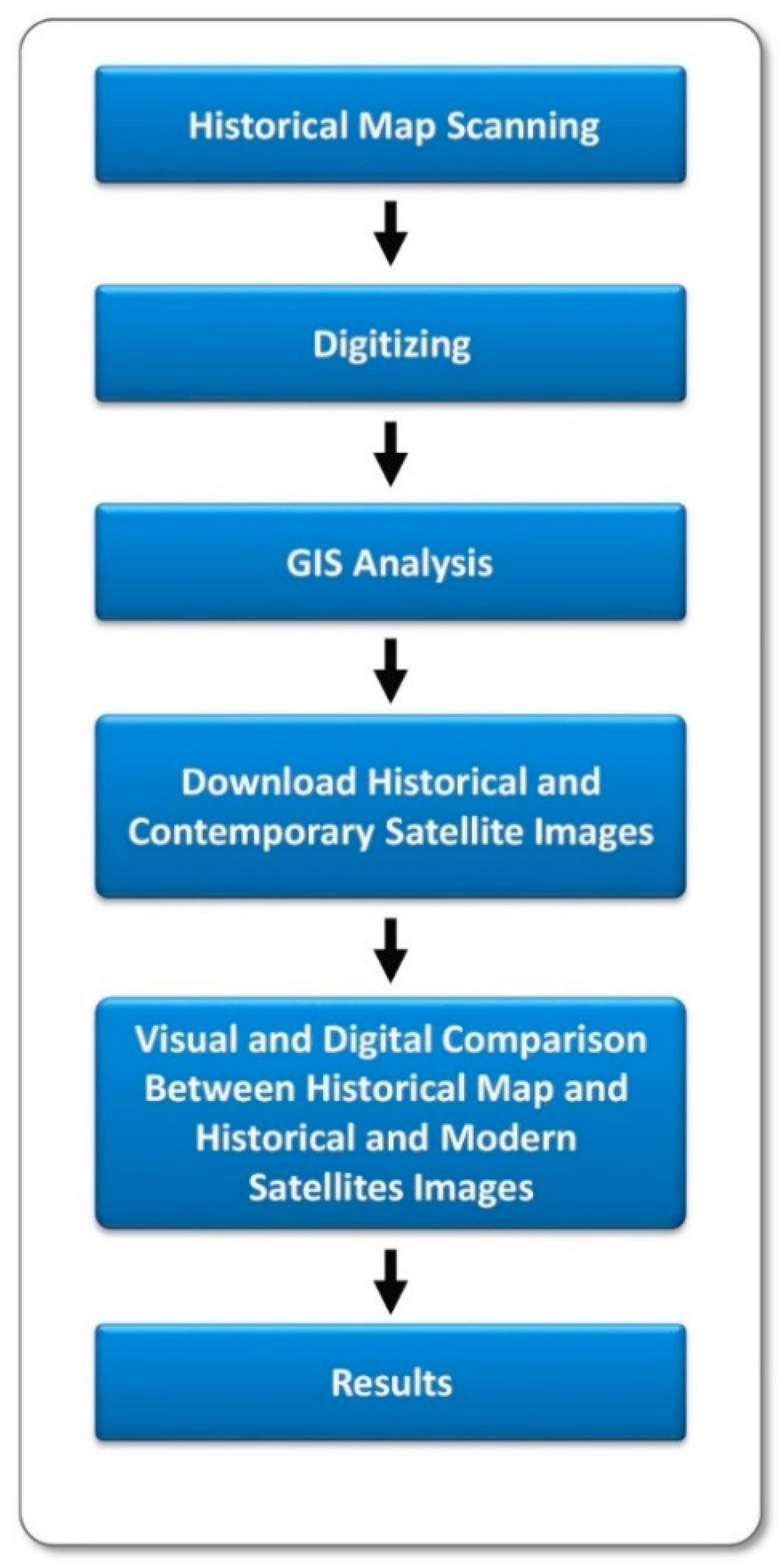

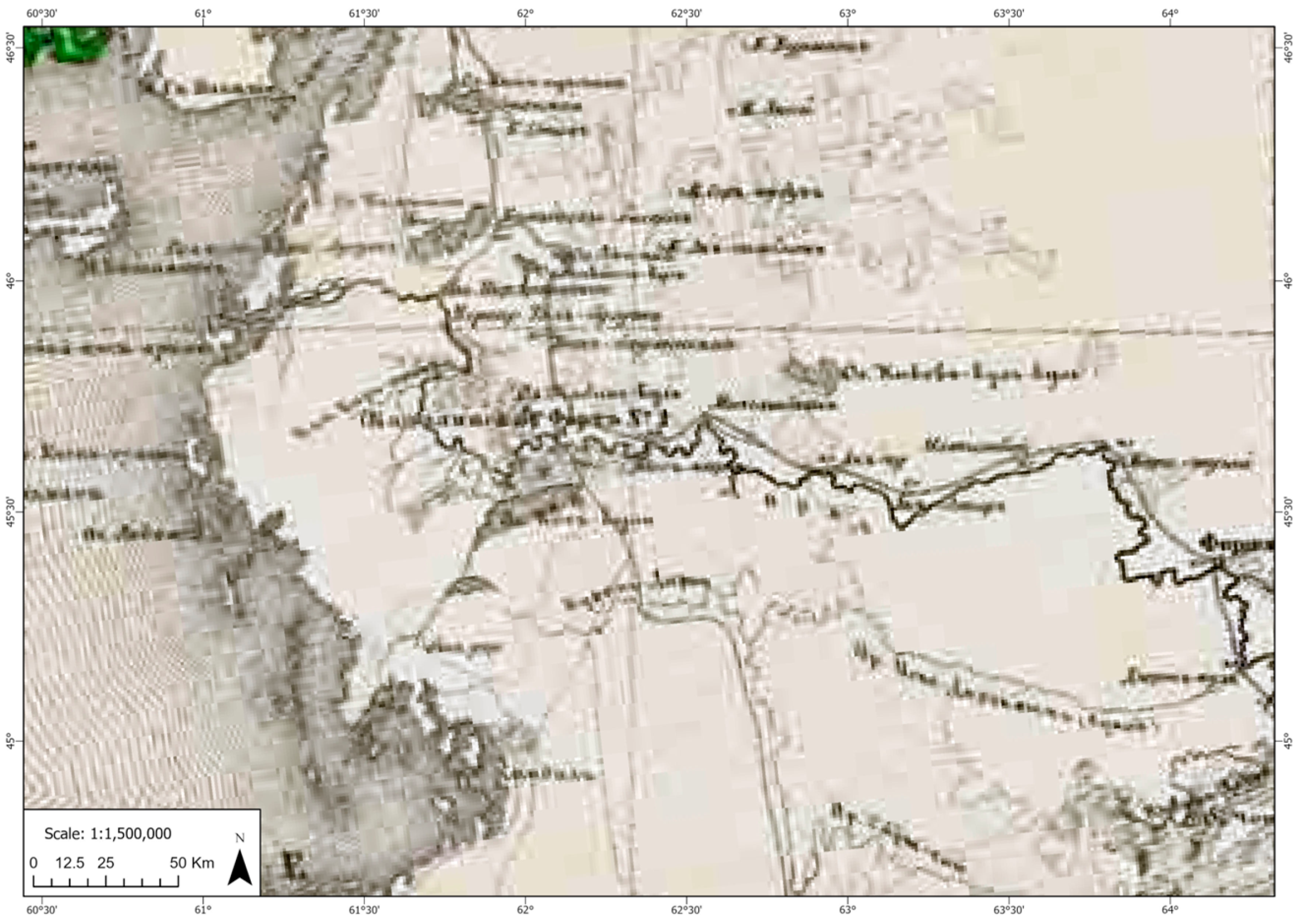

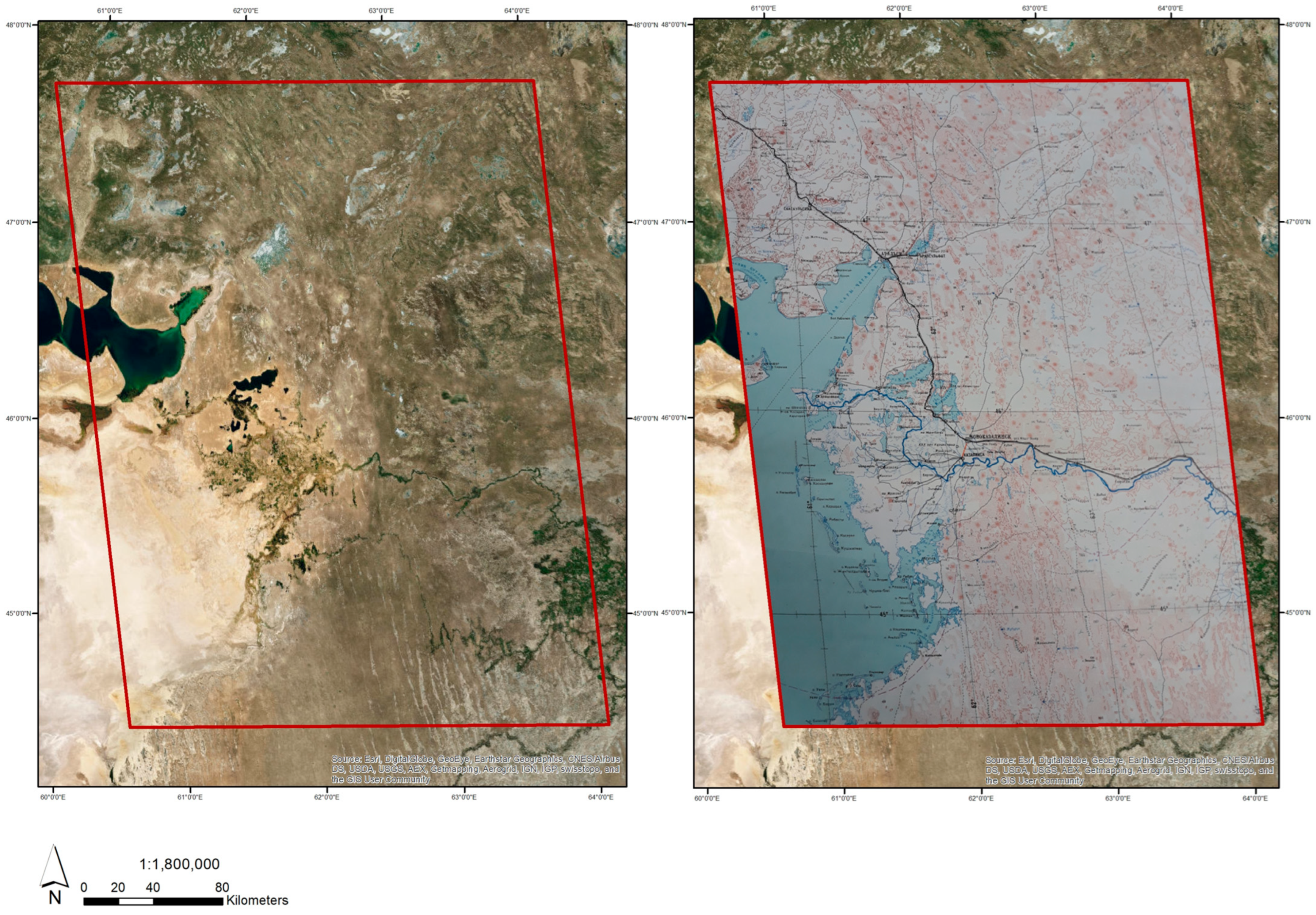


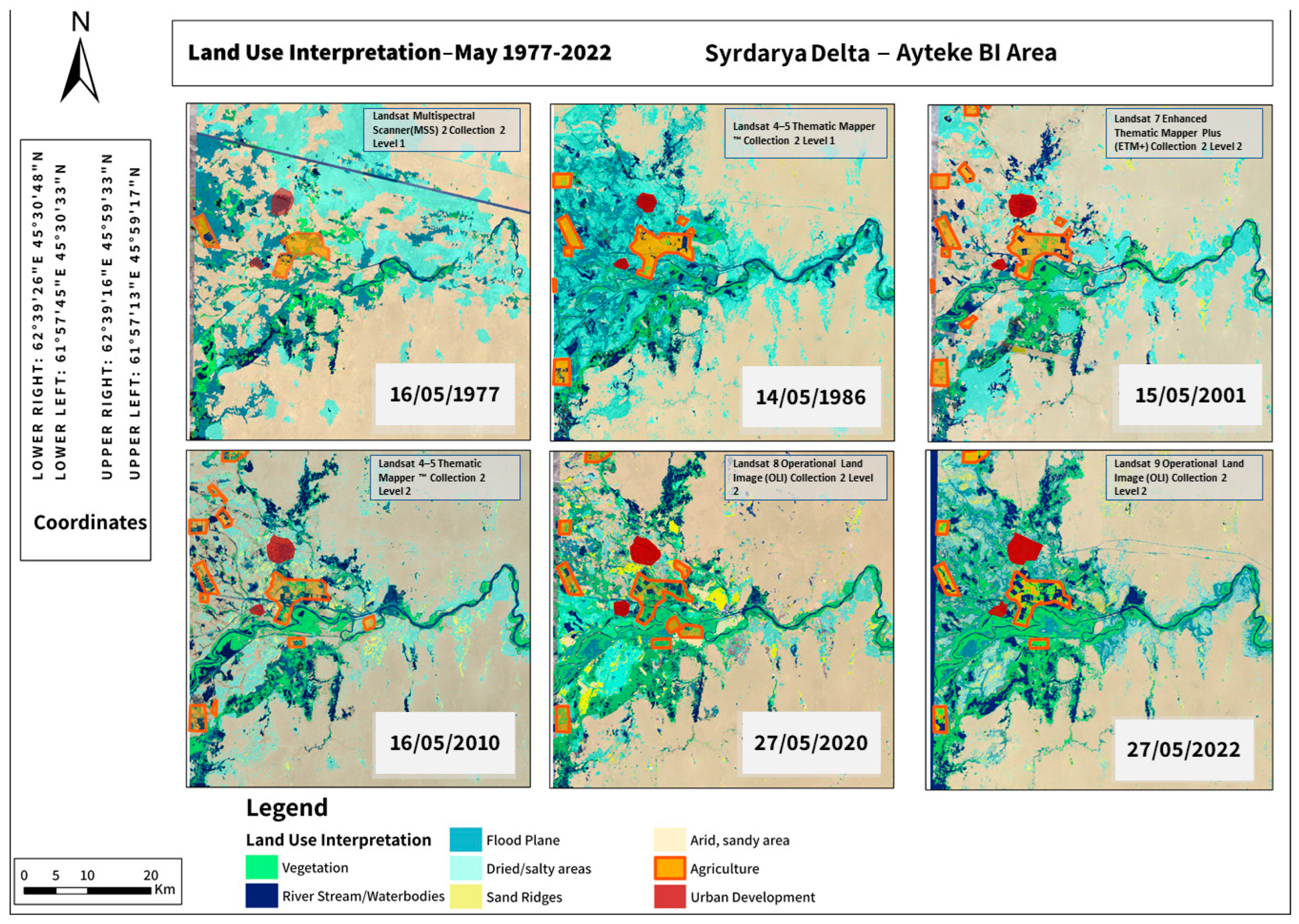
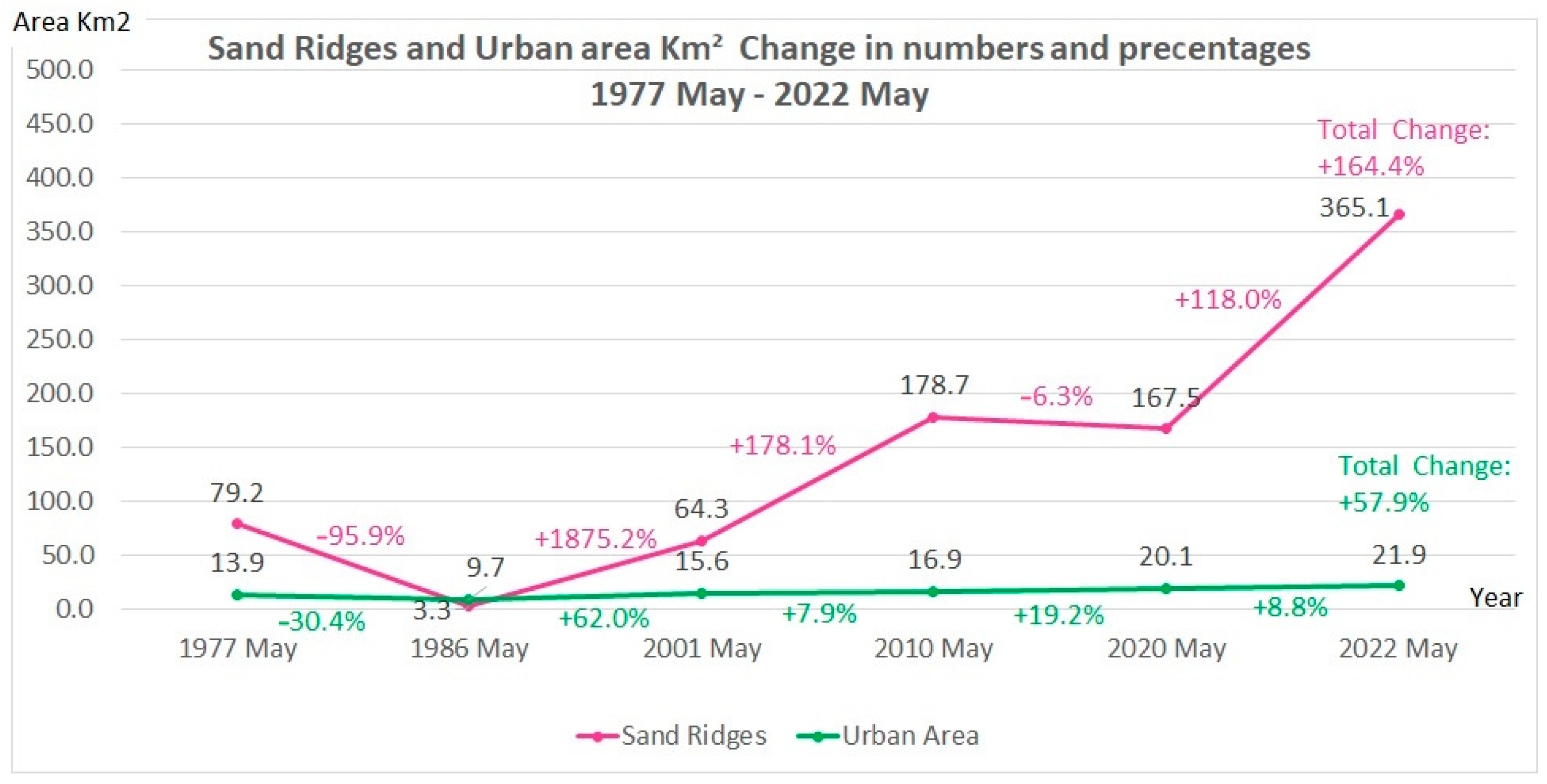
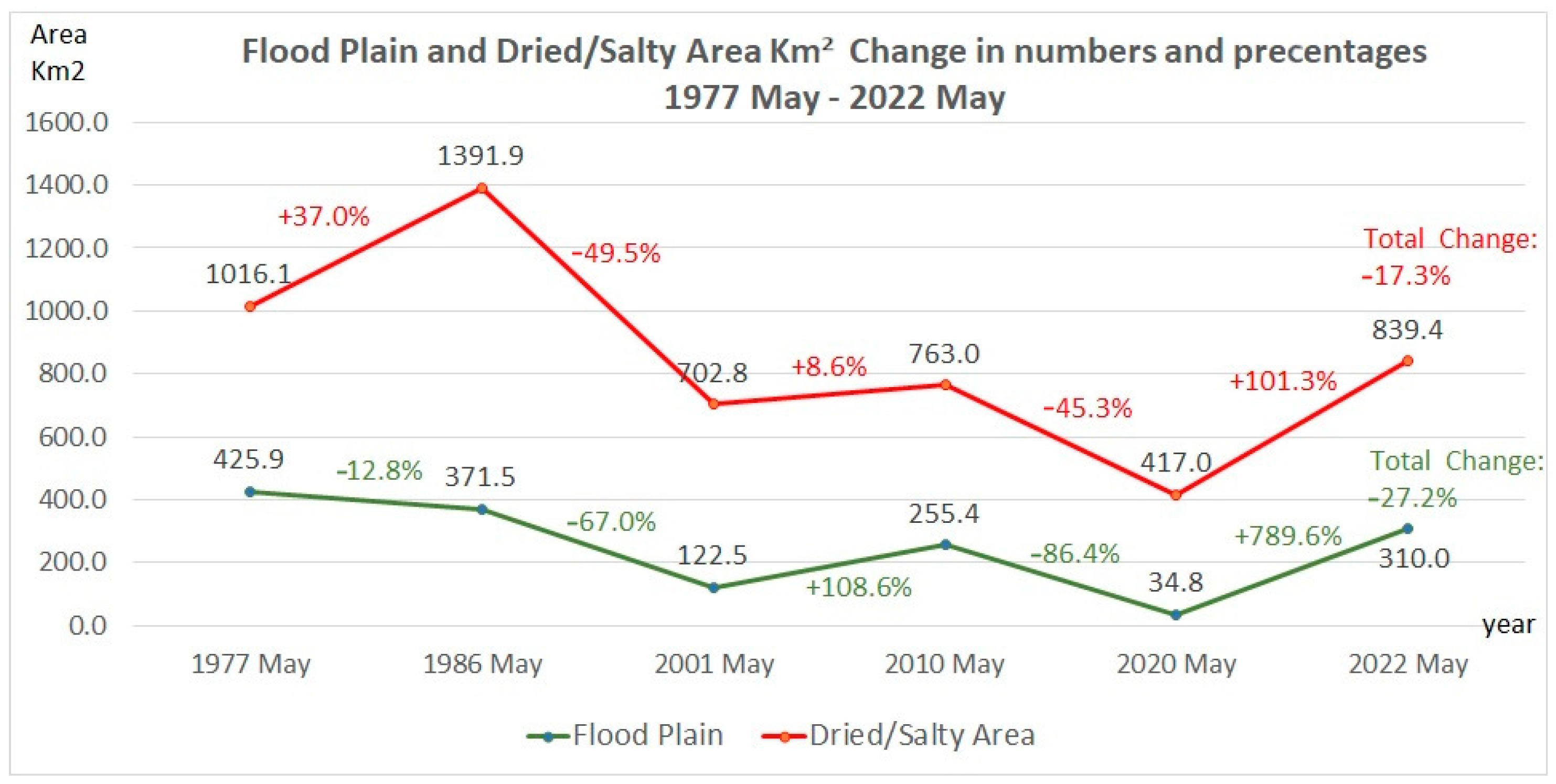

Disclaimer/Publisher’s Note: The statements, opinions and data contained in all publications are solely those of the individual author(s) and contributor(s) and not of MDPI and/or the editor(s). MDPI and/or the editor(s) disclaim responsibility for any injury to people or property resulting from any ideas, methods, instructions or products referred to in the content. |
© 2025 by the authors. Licensee MDPI, Basel, Switzerland. This article is an open access article distributed under the terms and conditions of the Creative Commons Attribution (CC BY) license (https://creativecommons.org/licenses/by/4.0/).
Share and Cite
Zofnat, Z.; Orlovsky, L.; Meir, I.A. Integration of Historical and Contemporary Data Sources in Understanding the Extent and Types of Disruptions in the Syrdarya Delta Land Use/Land Cover. Land 2025, 14, 639. https://doi.org/10.3390/land14030639
Zofnat Z, Orlovsky L, Meir IA. Integration of Historical and Contemporary Data Sources in Understanding the Extent and Types of Disruptions in the Syrdarya Delta Land Use/Land Cover. Land. 2025; 14(3):639. https://doi.org/10.3390/land14030639
Chicago/Turabian StyleZofnat, Zohar, Leah Orlovsky, and Isaac A. Meir. 2025. "Integration of Historical and Contemporary Data Sources in Understanding the Extent and Types of Disruptions in the Syrdarya Delta Land Use/Land Cover" Land 14, no. 3: 639. https://doi.org/10.3390/land14030639
APA StyleZofnat, Z., Orlovsky, L., & Meir, I. A. (2025). Integration of Historical and Contemporary Data Sources in Understanding the Extent and Types of Disruptions in the Syrdarya Delta Land Use/Land Cover. Land, 14(3), 639. https://doi.org/10.3390/land14030639





